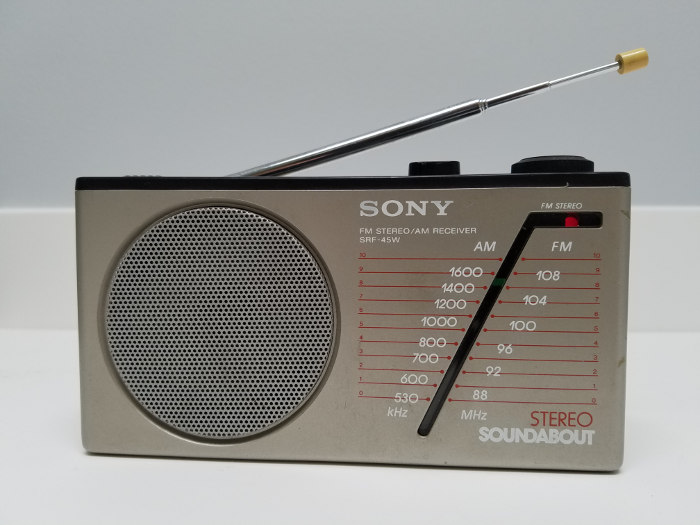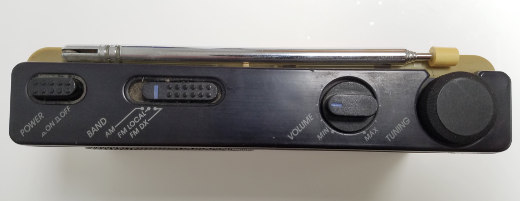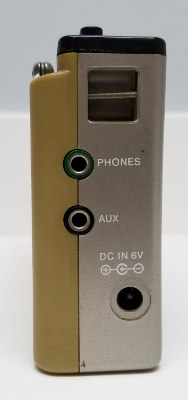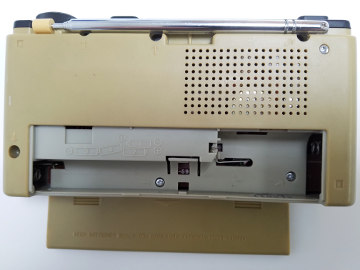
One of the more obscure radios in the Sony line, the SRF-45W carries the "Soundabout" name that's more closely associated with a line of combination cassette players and radios that were portable, yet a little larger than the typical Walkman. "Soundabout" players often had a built-in speaker in addition to the usual headphone jacks for listening. The Sony SRF-45W also has a speaker. Stereo listening requires the use of headphones.
"Soundabout" was also the original name intended for the Walkman line of cassette players. The name was changed shortly before it was rolled out. Still, that change didn't happen soon enough for at least one publication: in its July 1980 issue, Popular Science had a review of the original Walkman cassette player, which it referred to as the "Soundabout".
The radio's model number ends in "W", which is indicative of its relationship to the Sony Walkman line of radios. It also has a close resemblance to the Sony SRF-A100 AM stereo/FM stereo radio, with both radios having a dial pointer that moves through a window angled at about 45 degrees. At the same spot where the SRF-A100 provides a red LED as a tuning indicator, the SRF-45W has a red LED to indicate when it's picking up an FM stereo broadcast. The switches, knobs, and even the typeface used for labels on the top of the unit strongly resemble the SRF-A100 (see below).
These characteristics may also hint at the period of time during which the radio was part of the Sony line. The SRF-A100 was available from 1984 to 1986. I'm guessing that the SRF-45W was available around that time as well.

The radio has a couple of unique attributes compared to typical Sony Walkman radios.

In addition to the usual stereo headphone jack on the side of the unit (left), the SRF-45W also has an input jack, labeled AUX. Whenever another program source is plugged into this jack, it overrides the radio, allowing it to be used as a speaker. While the AUX jack is also a stereo jack, there's just one speaker. Using this radio as an auxiliary speaker results in monophonic sound. The two stereo input channels are mixed together automatically. It's also possible to use the AUX input while listening with headphones. In that circumstance, you get stereo sound from the headphones. I'm not quite sure when it would be worthwhile to use the radio in that way, but who knows?

The power input jack toward the bottom of the side of the unit hints at another difference, as does the back of the radio (right). Unlike most Sony Walkman-style radios, which require two or three batteries, this one requires four AA batteries. Possibly this design is intended to provide more power to the amplifier that drives the speaker. That said, the SRF-A100 AM stereo/FM stereo radio, which has two speakers, manages with three AA batteries.
The photo of the back of the unit also shows the degree to which the original color may have changed over time. I suspect the original color was the gray that you see in the battery compartment. The rest of the back of the case has a yellowish color. I had first thought this radio had spent time in a smoker's house, but it had no smoke odor. I have seen photos of other examples of this model, and they show the same color. Either this is the original color (in which case, I think it's a rather ugly choice), or the plastic becomes discolored over time.
The radio has a swiveling rod antenna that extends to slightly more than 20 inches (52 centimeters to be exact), not the correct 30-inch (76 cm) length for FM reception.
In any event, this isn't a radio that you're going to pick up distant signals with. AM performance is competent for local and nearby signals, as is FM performance. But the radio is only moderately selective and sensitive. It seems relatively free of FM front-end overload, but some false signals can still be found on the dial. There is a "local/distant" switch for FM reception, which generally indicates that overload can be a problem. However, on my unit, the switch must have been wired incorrectly by someone who repaired it. It appears that only the "local" position actually works. So I may not have the complete picture for FM performance on the SRF-45W. Based on my experience with other Sony models of this vintage, it's likely to be OK for local signals but weak or distant stations will probably get lost in the noise generated by strong local stations.
The quality of the sound coming out of the speaker can also be described as middling. It's somewhat reminiscent of my vintage Zenith radios, such as the Royal 76: not boomy or shrill, relatively pleasant, but still emphasizing midrange frequencies. It's better for talk or sports radio compared to listening to music stations.
In Europe, a model called the SRF-45L was sold. Its appearance was nearly identical to the SRF-45W. It covered longwave AM broadcasts (approximately 150-260 kHz) as well as standard mediumwave AM and FM. There is an additional mono/stereo switch on the top of the SRF-45L that allows FM reception to always be in mono. When listening to the speaker, that wouldn't be relevant anyway, but it is a nice added feature for headphone listening. I don't know whether the SRF-45L incorporates the AUX input jack that is a distinctive feature of the SRF-45W.
A photograph of the SRF-45L is in the book Radio Transistores by Juan Julià Enrich, published in 2012 by Marcombo S.A. in Barcelona, best acquired on a Kindle, and read with the Kindle app on a tablet. The book, in Spanish, has numerous color photos of the author's extensive collection of radios, with a section dedicated exclusively to Sony models.
I don't know the original price of the SRF-45W. I picked mine up off eBay for about $30, counting shipping costs, in 2020. Based on limited data, it appears that the SRF-45L was going for around £20 (about $25 in 2020) in the United Kingdom at the time this review was written in 2020.
The SRF-45W's appearance could be considered more notable than its performance. It's a middle-of-the-road choice for local radio reception, easy to use, with the most notable features being the AUX input and a beefier power supply than usual for a 1980s radio in this category.